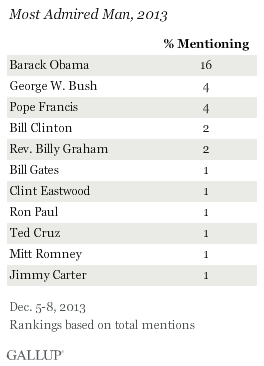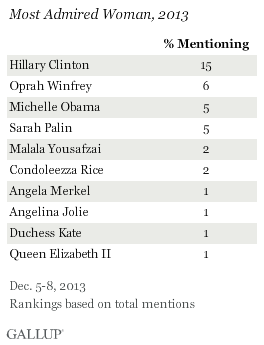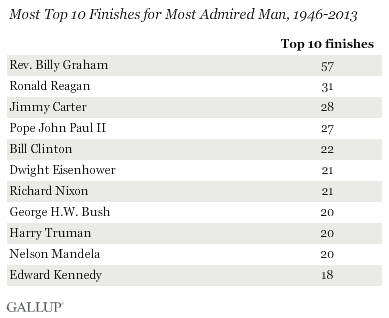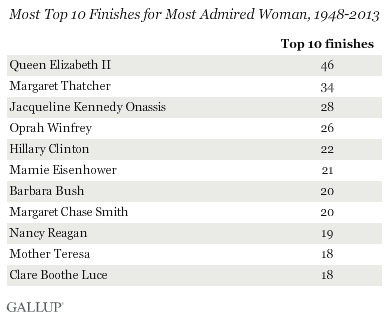PRINCETON, NJ -- For the sixth consecutive year, Barack Obama ranks as the Most Admired Man among Americans, and Hillary Clinton is again the Most Admired Woman. Both won by comfortable margins. Sixteen percent named Obama, compared with 4% each for former President George W. Bush and Pope Francis; Clinton (15%) finished ahead of television personality Oprah Winfrey (6%), first lady Michelle Obama (5%), and former Alaska Gov. Sarah Palin (5%).


Each year, Gallup asks Americans to name, in an open-ended format, the man and woman living anywhere in the world they admire most. This year's poll was conducted Dec. 5-8.
Obama has won Gallup's Most Admired Man designation each year since 2008, the year he was elected president. However, similar to his declining job approval rating this year, the percentage naming him fell to 16% from 30% in 2012.
The remainder of the top 10 Most Admired men includes three former presidents (Bush, Bill Clinton, and Jimmy Carter) and two religious leaders (the Rev. Billy Graham and Pope Francis). The sitting pope has finished in the top 10 each year since 1977. In addition to Pope Francis, actor, director, and political activist Clint Eastwood and Texas Sen. Ted Cruz finished in the top 10 for the first time.
This year's poll was conducted at the time of South African human rights leader Nelson Mandela's death. The widespread news coverage of his death helped make him top of mind for many Americans, and 7% named him as Most Admired Man. However, because the question wording specifically asks for the name of a living man or woman, Gallup does not rank deceased figures who are mentioned.
Hillary Clinton has been named Most Admired Woman a total of 18 times, more than any other woman in Gallup's history, including each of the last 12 years. Clinton first won the distinction in 1993, when she was first lady, and has continued to rank at or near the top of the list while serving in a variety of public roles including as U.S. senator and as secretary of state. The 15% naming her this year is down from 21% last year and is the lowest figure for her since 2006.
The top 10 Most Admired Woman list includes several political leaders such as Clinton, Palin, former Secretary of State Condoleezza Rice, and German Chancellor Angela Merkel, as well as humanitarian activists such as Winfrey, Malala Yousafzai (the Pakistani girl shot for trying to attend school), and Angelina Jolie. The queen of England and her granddaughter-in-law, Duchess Kate, also finished among the leading women. All of the women ranking in the top 10 have previously appeared on the list.
Graham, Queen Elizabeth II Extend Records for Top 10 Finishes
Graham has appeared in the top 10 list far more often than any other man, making his 57th appearance this year. He has never finished first, a spot typically taken by the sitting president, but has finished second on numerous occasions. Ronald Reagan has the second most top 10 finishes, but his 31 such finishes are 26 fewer than Graham's.
Carter's 28th top 10 finish this year moved him ahead of former Pope John Paul II for the third most top 10 appearances. Bill Clinton's 22nd top 10 spot ranks him fifth, now ahead of Dwight Eisenhower and Richard Nixon. Mandela frequently finished among the top 10, making his 20th and final top 10 appearance last year.

Gallup first asked Americans to name the Most Admired Woman in 1948. That year, Princess Elizabeth of England finished seventh. More than 60 years later, the now queen of England has finished in the top 10 a total of 46 times. Former British Prime Minister Margaret Thatcher, who died earlier this year, has the second most top 10 finishes among women, with 34. Former first lady Jacqueline Kennedy Onassis ranks third, followed by Winfrey and Clinton.

Implications
Clinton was named the Most Admired Woman this year for the 18th time. Unlike this year, each prior time she won she held an official government role. Her public service may not be complete, though, as she is frequently mentioned as a possible contender for the 2016 Democratic presidential nomination, and likely would be the clear front-runner if she decided to pursue it. She has dominated the Most Admired Woman list since becoming first lady in 1993, failing to finish first only in 1995 and 1996 to Mother Teresa, and in 2001 to Laura Bush.
It would not be surprising for Obama to continue to rank as the Most Admired Man for the duration of his presidency, as the sitting president has won the distinction 57 times in the 67 years the question has been asked, including the last 33 in a row. Given his relative youth at age 52, the esteem in which Americans hold former presidents, and his historical significance as the first African-American president, should he live a long life he likely will also rank among the men with the most top 10 appearances for all time.
Survey Methods
Results for this Gallup poll are based on telephone interviews conducted Dec. 5-8, 2013, with a random sample of 1,031 adults, aged 18 and older, living in all 50 U.S. states and the District of Columbia.
For results based on the total sample of national adults, the margin of sampling error is ±4 percentage points at the 95% confidence level.
Interviews are conducted with respondents on landline telephones and cellular phones, with interviews conducted in Spanish for respondents who are primarily Spanish-speaking. Each sample of national adults includes a minimum quota of 50% cellphone respondents and 50% landline respondents, with additional minimum quotas by region. Landline and cell telephone numbers are selected using random-digit-dial methods. Landline respondents are chosen at random within each household on the basis of which member had the most recent birthday.
Samples are weighted to correct for unequal selection probability, nonresponse, and double coverage of landline and cell users in the two sampling frames. They are also weighted to match the national demographics of gender, age, race, Hispanic ethnicity, education, region, population density, and phone status (cellphone only/landline only/both, and cellphone mostly). Demographic weighting targets are based on the March 2012 Current Population Survey figures for the aged 18 and older U.S. population. Phone status targets are based on the July-December 2011 National Health Interview Survey. Population density targets are based on the 2010 census. All reported margins of sampling error include the computed design effects for weighting.
In addition to sampling error, question wording and practical difficulties in conducting surveys can introduce error or bias into the findings of public opinion polls.
View methodology, full question results, and trend data.
For more details on Gallup's polling methodology, visit www.gallup.com.
